|
Michael McFadyen's Scuba Diving - SMS Kronprinz Wilhelm
The last battleship of the four-ship Konig class was ordered under the provisional name Ersatz Brandenburg. The keel was laid down in November 1911 (perhaps May 1911). At some time the name was changed to SMS Kronprinz. The new battleship was launched on 21 February 1914 from the Germania Dockyard in Kiel, Germany. One of her sisterships was SMS Markgraf (which is very relevant as you will see later).
Named after Crown Prince Wilhelm (the son of the Kaiser, Wilhelm II), the new warship was 175.4 metres long (I have also seen 154 and 146 metres as the length - I think the longer one is correct when you compare the plans below)) with a beam of 29.5 metres. She drew 9.19 metres and displaced 29,669 tons full load. She was powered by 3 Parsons steam turbines driving three props. The turbines had a combined 43,300 shp. The steam came from 3 oil-fired and 12 coal-fired boilers. She carried 600 tons of oil and 3,000 tons of coal. She had a maximum speed of 21 knots with a range of 8,000 nautical miles. She was manned by 41 officers and 1,095 enlisted men.
The Kronprinz was originally slated to be completed in 1915 but after the outbreak of World War I in mid-1914, fitting out was sped up. She was commissioned into the Imperial Navy on 8 November 1914 (I have also read 8 August 1914). The cost of the vessel was 45 million Goldmarks.
The Kronprinz was armed with 10 12 inch SK L/50 guns arranged in five twin gun turrets. There were two superfiring turrets each fore and aft and one turret amidships between the two funnels. Other armament consisted of 14 5.9 inch SK L/45 quick-firing guns, six 3.5 inch SK L/45 quick-firing guns and five 20 inch underwater torpedo tubes, one in the bow and two on each beam.
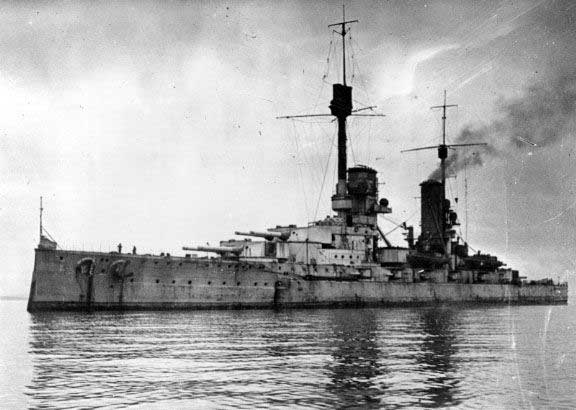 |
| SMS Kronprinz |
SMS Kronprinz completed her sea trials on 2 January 1915. Her skipper was Captain Baron Gottfried von Dalwigk. Her first work was an uneventful sortie into the North Sea on 29 to 30 March. Three weeks later, on 17 and 18 April, she and her sisters supported an operation in which the light cruisers of the II Scouting Group laid mines off the Swarte Bank which is about 120 kilometres off the English coast north-east of Norwich.
Apart from exercises and a few other minelaying operations, the Kronprinz did little through 1915 and 1916. From August 1915 her commander was Captain Constanz Feldt. On 24 April 1916 Kronprinz supported a raid on the English coast conducted by the German battlecruiser force of the I Scouting Group. They left the Jade Estuary and on the way the battlecruiser Seydlitz struck a mine and had to withdraw. The other battlecruisers bombarded the town of Lowestoft (east of Norwich) unopposed, but during the approach to Yarmouth, they encountered British cruisers. A short gun duel ensued before the British ships withdrew.
Kronprinz was present during the Battle of Jutland which took place on 31 May and 1 June 1916. This was the only real naval battle of the war. The German fleet sought to draw out and isolate a portion of the British Grand Fleet and destroy it before the main British fleet could retaliate. Kronprinz was the rearmost ship of the V Division of the III Battle Squadron, the vanguard of the fleet.
She followed her sisterships Konig, Grosser Kurforst and Markgraf. Shortly before 4:00 pm, the battlecruisers of I Scouting Group encountered the British 1st Battlecruiser Squadron under the command of David Beatty. The opposing ships began an artillery duel that saw the destruction of HMS Indefatigable, and HMS Queen Mary within 90 minutes.
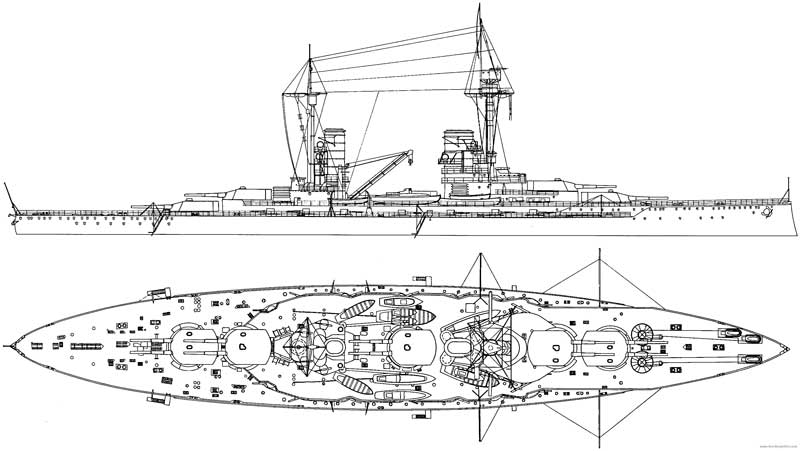 |
| Plans of the Konig class battleships |
Later in the battle, Kronprinz fired at HMS Dublin and then the fast battleship HMS Malaya. Kronprinz landed no hits on either ship.
Shortly after 7:00 pm, the destroyer HMS Onslow fired two torpedoes at Kronprinz at a range of 7,300 m but both missed.
Soon after this, the cruiser HMS Defence was struck by several shells from German ships. One went into the ship's ammunition magazines and a massive explosion destroyed the cruiser. It is possible that it was a shell from Kronprinz that destroyed the ship.
Kronprinz then attacked HMS Warrior, badly damaging her. She was unable to reach port and was abandoned the following morning.
Just after 10:30 pm, Kronprinz was violently shaken by several near misses. After midnight, a torpedo, fired by the destroyer HMS Obedient, exploded about 90 metres behind Kronprinz. The Battle of Jutland was over, with the Germans probably considered the winners.
On 18 August 1916, Kronprinz took part in an operation to bombard Sunderland. This was an attempted repeat of the original 31 May plan. A number of ships were to bombard the coastal town of Sunderland in an attempt to draw out and destroy the British battlecruisers. The rest of the fleet, including Kronprinz, would trail behind and provide cover. In the end, the British were aware of the German plan and sent the Grand Fleet to meet them. Unwilling to engage the whole of the Grand Fleet just eleven weeks after the decidedly close call at Jutland, the Germans turned around and retreated to their ports.
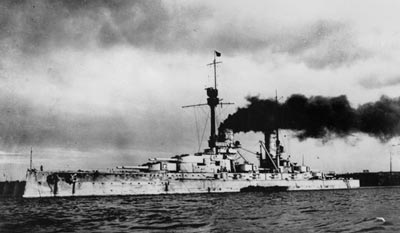 | 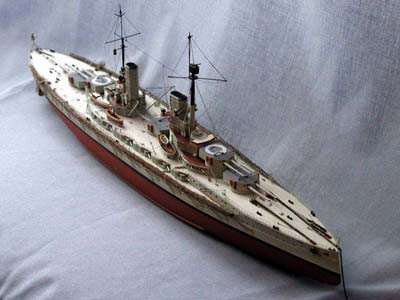 |
| SMS Kronprinz | A model of SMS Kronprinz |
Kronprinz participated in two other events, one a month prior on 16 July 1916 to the north of Helgoland, and one into the North Sea on 18 to 20 October 1916. After this, Kronprinz (and the rest of III Squadron) were sent to the Baltic for training which lasted until 2 November. After returning from the Baltic, Kronprinz was sent (as a part of a larger group) to cover the recovery of a pair of U-boats that were stranded on the Danish coast. On 5 November 1916 when returning, Kronprinz was torpedoed by the British submarine J1 near Horns Reef. The torpedo struck the ship beneath the forward-most gun turret and allowed approximately 250 metric tonnes of water into the ship. Kronprinz maintained her speed and reached port. Her skipper from November 1916 was Captain Bernhard Rosing.
The following day she was placed in drydock at the Imperial Dockyard in Wilhelmshaven for repairs which lasted until 4 December. After repairs she took part in training in the Baltic before undertaking patrols in the German Bight. During training on 5 March 1917, Kronprinz was rammed by her sister ship SMS Grosser Kurforst in the Heligoland Bight. The collision caused minor flooding. She again went into the drydock in Wilhelmshaven from 6 March to 17 May 1917. On 11 September 1917, Kronprinz was detached for training in the Baltic after which she joined the Special Unit for Operation Albion.
In early September 1917, following the German conquest of the Russian port of Riga, the German navy decided to eliminate the Russian naval forces that still held the Gulf of Riga. The Navy High Command planned an operation to seize the Baltic island of Osel, and specifically the Russian gun batteries on the Sworbe Peninsula. The Kronprinz was part of a naval fleet that included the other Konig-class ships. The entire force numbered some 300 ships, supported by over 100 aircraft and six zeppelins. There were approximately 24,600 officers and enlisted men in the land-based group.
The attack began on 12 October 1917 when at 3:00 am the Konig anchored off Osel in Tagga Bay and disembarked soldiers. Around 5:50 am the Konig opened fire on Russian coastal artillery emplacements and was soon joined by the Moltke, Bayern and the other three Konig-class ships, including the Kronprinz. After the bombardment, the Kronprinz departed for Putziger Wiek where she refuelled.
On 16 October 1917 it was decided to send the Kronprinz and Konig along with the cruisers Strassburg and Kolberg and a number of smaller vessels to engage the Russian battleships in Moon Sound. The next day they arrived and found that the 30.5 cm guns of the Russian battleships out-ranged their own 30.5 cm guns. A minefiled stopped the German ships getting closer to the Russians. At 10:00 am minesweepers cleared a path through the minefield. The Kronprinz and Konig moved into the bay and shortly after the Kronprinz opened fire on Tsarevitch and Bayan, scoring hits on both. At the same time, Konig sank the Slava. The Russian ships were hit dozens of times and only 30 minutes after it started, the Russian naval commander ordered the withdrawal of his ships.
On 18 October 1917 Kronprinz ran aground but the damage was not serious enough to necessitate withdrawal for repairs. By 20 October 1917 the fighting on the islands was winding down and the larger ships were to be returned to the High Seas Fleet as soon as possible. On 26 October 1917 Kronprinz was more seriously grounded on the return trip to Kiel. She managed to reach Kiel on 2 November 1917 and then Wilhelmshaven. Repairs were effected from 24 November 1917 to 8 January 1918.
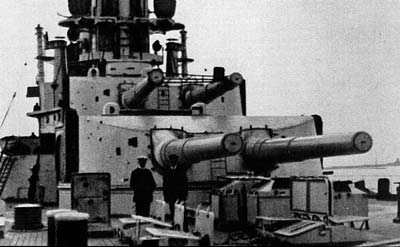 | 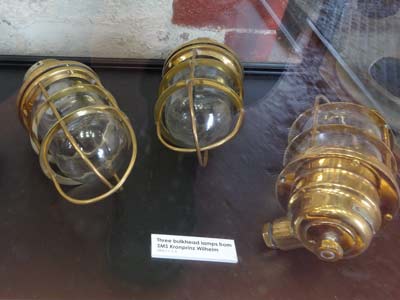 |
The number one and two turrets
of SMS Konig, identical to the Kronprinz | Lights from SMS Kronprinz Wilhelm,
on display in the Lyness museum |
On 27 January 1918, the Kaiser directed that the ship be renamed SMS Kronprinz Wilhelm in honour of the Crown Prince. The ship was formally renamed on 15 June 1918, the 30th anniversary of the Kaiser's reign. From August 1918 her skipper was Captain Otto Seidensticker. Kronprinz Wilhelm and her three sisters were to have taken part in a final fleet action at the end of October 1918, just days before the Armistice was to take effect. The bulk of the High Seas Fleet was to have sortied from their base in Wilhelmshaven to engage the British Grand Fleet with the idea of inflicting as much damage as possible on the British navy. This was an attempt to get a better bargaining position for Germany in the now certain to come armistice.
Many of the German sailors were sick of the war and felt the operation would disrupt the peace process and prolong the war. On the morning of 29 October 1918 the order was given to sail from Wilhelmshaven the following day. Starting on the night of 29 October 1918, sailors on Thoringen and then on several other battleships, including Kronprinz Wilhelm, mutinied. The unrest ultimately forced the cancellation of the operation.
Along with the most modern units of the High Seas Fleet, Kronprinz Wilhelm was included in the ships specified for internment by the victorious Allied powers. The ships steamed out of Germany on 21 November 1918 in single file, commanded by Rear Admiral Ludwig von Reuter. They were met at sea by a combined fleet of 370 British, American and French warships. The fleet arrived in the Firth of Forth (Edinburgh) later that day. Then, between 25 and 27 November 1918 they were escorted to Scapa Flow in the Orkney Islands, Scotland. Upon arrival, all wireless equipment was removed from the ships and the breech blocks of their heavy guns were removed to prevent their use. Crews were reduced to minimum levels.
The fleet remained in captivity during the negotiations that ultimately produced the Treaty of Versailles. Reuter believed that the British intended to seize the German ships on 21 June 1919 which was the deadline for Germany to have signed the peace treaty. Unaware that the deadline had been extended to 23 June 1919, Reuter ordered the ships to be sunk at the next opportunity. On the morning of 21 June 1919 the British fleet left Scapa Flow to conduct training manoeuvres, and at 11:20 am Reuter transmitted the order to his ships. Kronprinz Wilhelm sank at 1:15 pm.
Karl Bauer, a stoker on the Kronprinz Wilhelm was shot and killed by repeated firing from British soldiers on two boats during the scuttling of the fleet on 21 June 1919. The British guards had panicked during the scuttling. Karl Bauer is buried in the naval cemetery at Lyness, Hoy.
The majority of the German ships were salvaged in the 1920s and 1930s. A number of companies salvaged some wrecks and then Ernest Cox of Cox & Danks raised the majority of the ships. Later work by Metal Industries Ltd in the 1930s raised more. After all this work, only seven of the 52 ships remained, although there are parts of others which are still on the bottom of Scapa Flow. Later salvage work in the 1960s and 1970s by Nandy (Marine Metals) Ltd and then Scapa Flow Salvage Co Ltd under Dougall Campbell removed materials from the remaining ships.
The salvage work on the Kronprinz Wilhelm included remove the props (by Metal Industries), a lot of the 12 inch armour plating along the sides of the hull (by Scapa Flow Salvage) as well as torpedo tubes and engine turbines (Nandy I think).
Today the wreck of the Kronprinz Wilhelm lies in about 38 metres on a sandy bottom at N58Âș 53.64' W3Âș 09.79' with her bow pointing to the north-west. She is about 1.1 kilometres north-east of the northern point of Cava Island. The wreck is almost totally upside-down, with the port side a fair bit higher off the sand than the starboard side which is on or in the sand. In 2013 there was a shotline on the port railing about one quarter of the way forward from the stern. This is above the stern 12 inch gun turret.
Due to the huge size of this wreck as well as the depth of over 35 metres to the bottom, you need two dives to even get a good understanding of the wreck. For a first dive, I would recommend diving from the shotline to the stern and back forward past where you descending and then surfacing from wherever you get to (unlikely to be the bow). A second dive would be to the bow (which I did not do).
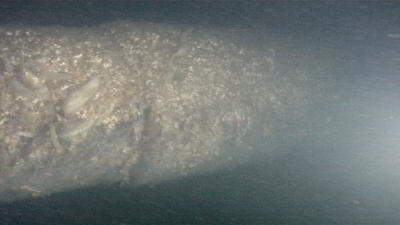 | 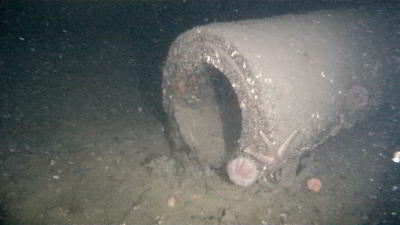 |
One of the 12 inch gun barrels on
SMS Kronprinz near the turret | The end of the same gun barrel |
Once you have decended, you may pass over the hull of the ship (which is only 12 metres below the surface) if the shotline is lying in the right direction. Otherwise the first you will see of the wreck is the port side of the hull as you approach the railing where the shot is tied off. This will be at about 26 metres.
Straight below this are the two rear 12 inch gun turrets. The number 5 turret sits on the sand, with both its guns visible. The closest one sits on the sand and the one behind sits high off the sand. You can swim under the first one and towards the stern between the two gun barrels. Looking back towards the turret is an amazing sight, a pity that you cannot get further back and see the ends of the barrels.
Turret number 4 is to the right of the rearmost turret as you face them from outside and sits off the bottom. The two gun barrels angle down to the sand, with the one closest to you sitting on the top of the sand. You can see the end of the barrel very clearly. These guns are huge, the biggest you will see anywhere in the world on a sunken ship I think. Amazing. Again, it is very dark here as you are right under the upturned ship, so you will need a very good torch to appreciate it fully.
From here, you head back outside the wreck and a forward a little (with the wreck on your left) at about 32 metres. Here you can see one of the smaller 5.9 inch casemate guns. The barrel of this gun is pointed outwards. From here head towards the stern (with wreck on your right). It is perhaps 40 metres to the actual stern. As you approach it, you will see that the size of the side of the hull drops quite dramatically in size.
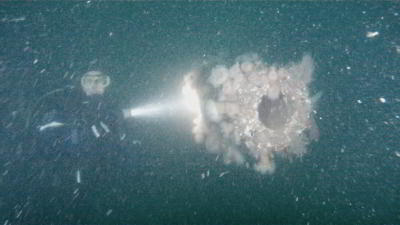 | 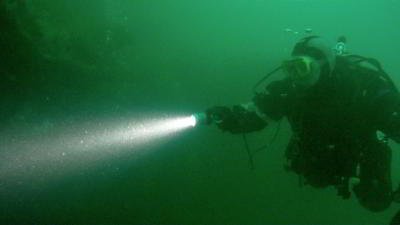 |
| Kelly and one of the 5.9 inch guns on SMS Kronprinz | Another shot of Kelly on SMS Kronprinz |
The stern is quite small in comparison to the rest of the wreck. It is a rounded stern, with very attractive features, almost feminine compared to the main part of the wreck. Sticking up out of the hull just forward are the twin rudders. These are not straight and tall like the Markgraf's rudders. They are very twisted, damaged by the salvage work removing the props and prop shafts. You will have been down about 15 minutes by now. You can look into the hull and see the steering mechanisms for each rudder. Go around the stern and along the starboard side.
Forward from this the hull rises up fairly dramatically. This is where the prop shafts would have been, but they are missing, with holes where the shafts exited the hull visible. Head forward, either up and along the hull bottom or cross back over to the side you came down and follow the wreck with it on your left. Once back near the rear gun turrets and the shotline, you can either ascend to the top of the wreck and shoot your SMB or do some more exploring, depending on your air and decompression requirements.
When I got back here at about 20 minutes we only had a few minutes at six metres, so we spent another six minutes looking around before we started our ascent. You can see another casemate 5.9 inch gun a little forward of the one you probably already saw.
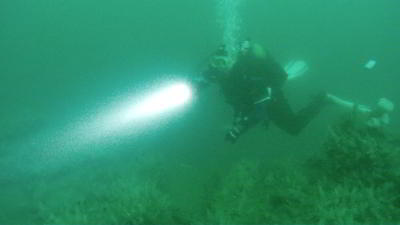 | 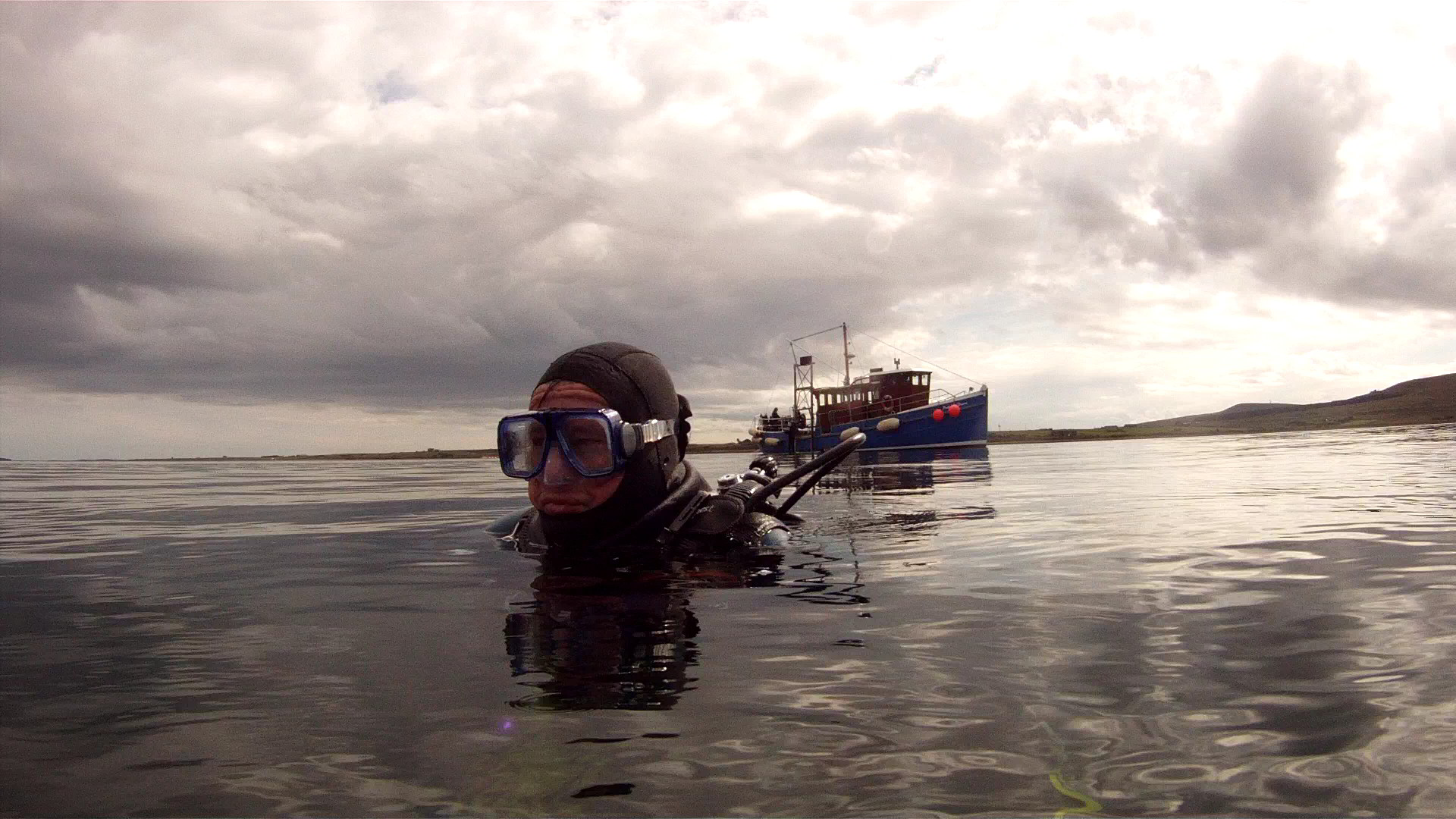 |
| Yet another photo of Kelly on SMS Kronprinz | Michael waiting on the surface for a pickup by Radiant Queen |
If you have a lot more time (eg using twins), you could go forward more before ascending to the top of the wreck to shoot an SMB. We ascended back up the tied off shotline, but it was a little hard to refind as we had poor visibility and the fact that the line was running off away from the wreck did not help.
We started our ascent from 26 metres at about 26 minutes. This gave us about 2 minutes at 9 metres (which disappeared by the time we got to 9 metres) and 6 minutes at 6 metres (using 26% Nitrox and 50% deco mix - shallow deco at 6 metres).
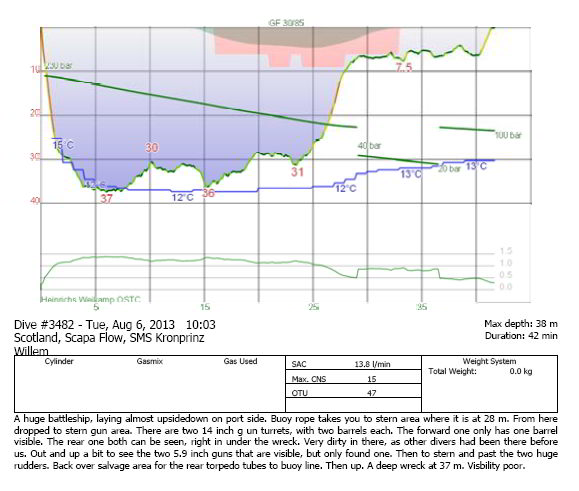 |
| A download from my computer showing our profile for the dive to the stern and midships of SMS Kronprinz Wilhelm |
This is an extremely good wreck, probably one of the best at Scapa Flow. The huge size means that you need many dives to really appreciate it and understand it. If this wreck was anywhere else in the world, you would spend a whole week diving on it. There are normally currents on the wreck, running either from bow to stern or stern to bow. The current when we dived was very light from the bow and this was near the time when tides should have been the strongest for the month. Water temperature was 12ÂșC when we dived in August. It gets as low as 6ÂșC in the early part of the season (April) and up to 13ÂșC in early September. Visibility on this wreck was not great, perhaps seven metres at the best and averaged about five metres.
I used a 15 litre tank on this dive, starting with about 230 bar and ending up with about 100 bar at the end. We also used a pony with 50% for all the decompression. We used GFs of 30/85 on our computers.
All underwater photos taken from video using a GoPro camera.
Kelly and I dived with MV Radiant Queen. The owners built a new boat since then which is called MV Huskyan. I would recommend them as we thought the operation was the best overall day charter boat we have used anywhere in the world and the new boat is heaps better than the old one.
Click here to see the list of wrecks
References:
| 
 v6.00.307 © 2003-2005
v6.00.307 © 2003-2005